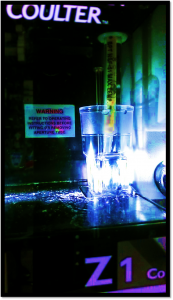
(This machine doesn’t actually use fluorescence, but it was far more photogenic than the machine that did. Coulter counters count cells using changes in impedance. Sorry about sacrificing scientific accuracy in the name of art. It’s the designer in me.)
In our lab, we used Picogreen, a reagent used to sort out double-stranded DNA from RNA, single-stranded fragments, and random free nucelotides. When the reagent encounters double-stranded DNA, it binds to the molecules and fluoresces. Keeping track of the fluorescent signals helps the scientists to know more about the quality of their samples.
I’ve been feeling rather like a free nucleotide floating in the miasma for much of this project. The past week, however, I had to put together a slide show for my lab explaining what I learned, and I realized that more “stuck” than I realized. I missed the individual signals, but found substance in the aggregate.
So my fluorescent moment is that learning can be slow and subtle, even to the point where we might miss it on the first scan. But once the catalyst starts to work, and we know what to look for, those tiny points of light coalesce into something illuminating, brilliant, beautiful.